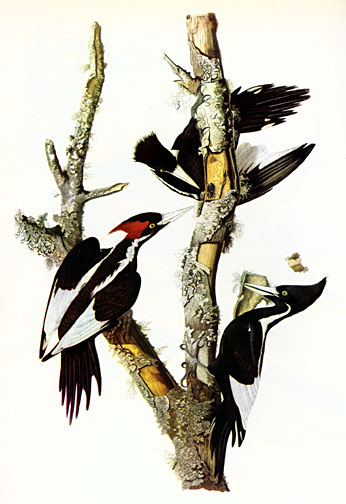
Ivory-Billed Woodpecker trio, Campephilus principalis,
by John James Audubon.
Hey everyone, it might surprise you to learn that I saw ivory-billed woodpeckers in NYC recently! Even better, I saw a trio, and I stood so close that I could have reached out and touched them! I clearly saw the spectacular iridescent flash of red from the male's crest, the two nearly parallel white stripes down the birds' backs, the snowy wings, and the huge pale bills. After such a close look at them, there was no mistaking these birds for anything other than ivory-billed woodpeckers.
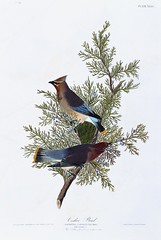 How did I manage to see these magnificent birds in NYC of all places? These birds were the subject of a watercolor painting by John James Audubon, one of the foremost bird painters the world has ever seen. Each spring since 2004, the New York City Historical Society has displayed 40 or so of Audubon's original bird watercolors on a rotating basis. Due to the recent news of the presumed rediscovery of the ivory-billed woodpecker, this is the second showing for this painting (I also saw it last year), which will be conserved soon by the museum. Next to the painting, you can see Tanner's 1935 black-and-white video of what appears to be a female ivory-billed woodpecker, as she calls and pokes around in the bark of her nest tree.
How did I manage to see these magnificent birds in NYC of all places? These birds were the subject of a watercolor painting by John James Audubon, one of the foremost bird painters the world has ever seen. Each spring since 2004, the New York City Historical Society has displayed 40 or so of Audubon's original bird watercolors on a rotating basis. Due to the recent news of the presumed rediscovery of the ivory-billed woodpecker, this is the second showing for this painting (I also saw it last year), which will be conserved soon by the museum. Next to the painting, you can see Tanner's 1935 black-and-white video of what appears to be a female ivory-billed woodpecker, as she calls and pokes around in the bark of her nest tree.
Also on view was the recently conserved ruby-throated hummingbird, Archilochus colubris, which appears side-by-side with Joseph Kidd's copy in oils. This painting originally appeared (before conservation) as part of the 2004 Audubon watercolor exhibition "The Birds of Central Park." Other paintings that you can expect to see include cedar waxwings, Bombycilla cedrorum (pictured above right), American robins, Turdus migratorius, Eastern meadowlarks, Sturnella magna, sandhill crane, Grus canadensis (which Audubon believed was an immature "hooping crane"), stilt sandpipers, Calidris himantopus, an unlikely collection of five native north American woodpecker species, and the brilliantly colored Western and scarlet tanagers Piranga ludoviciana and P. olivacea (pictured, below left).
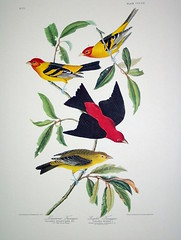 Even though I could easily tell you something interesting about every painting in the show, I was particularly impressed with several paintings. First, the painting of the Connecticut warbler, Oporornis agilis (pictured, below right), was accompanied by its engraved steel-plated copper plate along with a print made from that plate, giving an insider's view of how these images were reproduced for publication before the advent of digital imaging technologies. Also interesting was the great egret, Ardea alba (pictured, below left); this portrait of a elegant snowy bird against a charcoal-colored sky beautifully reveals the intricacies of the bird's delicate plumage -- a plumage that was so coveted by ninteenth century milliners that this species was nearly exterminated. A magnifying glass (provided by the Society) further exposes the fine details for how Audubon rendered these plumes with watercolors.
Even though I could easily tell you something interesting about every painting in the show, I was particularly impressed with several paintings. First, the painting of the Connecticut warbler, Oporornis agilis (pictured, below right), was accompanied by its engraved steel-plated copper plate along with a print made from that plate, giving an insider's view of how these images were reproduced for publication before the advent of digital imaging technologies. Also interesting was the great egret, Ardea alba (pictured, below left); this portrait of a elegant snowy bird against a charcoal-colored sky beautifully reveals the intricacies of the bird's delicate plumage -- a plumage that was so coveted by ninteenth century milliners that this species was nearly exterminated. A magnifying glass (provided by the Society) further exposes the fine details for how Audubon rendered these plumes with watercolors.
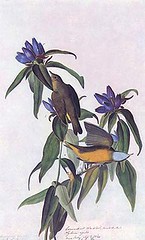 My favorite portraits were the side-by-side bald eagles, Haliaeetus leucocephalus, that Audubon painted several years apart. In both pieces, the eagle is in the same pose, but after that, the differences are obvious. First, the bird in the earlier painting is standing on a dead goose, while the bird in the second, later, painting is standing on a large catfish (pictured at bottom). The whiteness of the catfish contrasts nicely with the eagle's rich brown plumage, instead of competing for the viewer's eye, as does the strong coloring of the goose. But even more impressive is the technical improvement in the second eagle over the first; the coloring is richer and more subtle, the face and eye possess a fierce wildness that is lacking in the first, and the bird's attitude appears so much more alive than the bird in the first portrait.
My favorite portraits were the side-by-side bald eagles, Haliaeetus leucocephalus, that Audubon painted several years apart. In both pieces, the eagle is in the same pose, but after that, the differences are obvious. First, the bird in the earlier painting is standing on a dead goose, while the bird in the second, later, painting is standing on a large catfish (pictured at bottom). The whiteness of the catfish contrasts nicely with the eagle's rich brown plumage, instead of competing for the viewer's eye, as does the strong coloring of the goose. But even more impressive is the technical improvement in the second eagle over the first; the coloring is richer and more subtle, the face and eye possess a fierce wildness that is lacking in the first, and the bird's attitude appears so much more alive than the bird in the first portrait.
 In addition to paintings, this show includes video and sound recordings of the birds themselves, making the gallery feel more like a walk through the forest and along the seashore than a large room in an even larger city. Also included are other interesting artifacts, such as bird study skins (loaned from the AMNH, which is across the street), photos of Audubon's house that was once located on 155th and Broadway in Manhattan, along with a wood plank from the porch, and Audubon's hair trimmings that had been gathered into a box by his wife, Lucy Bakewell Audubon.
In addition to paintings, this show includes video and sound recordings of the birds themselves, making the gallery feel more like a walk through the forest and along the seashore than a large room in an even larger city. Also included are other interesting artifacts, such as bird study skins (loaned from the AMNH, which is across the street), photos of Audubon's house that was once located on 155th and Broadway in Manhattan, along with a wood plank from the porch, and Audubon's hair trimmings that had been gathered into a box by his wife, Lucy Bakewell Audubon.
The New York Historical Society is the largest single repository of Auduboniana in the world. Besides cataloguing a variety of Audubon's personal effects, they hold 435 of Audubon's watercolors that were preparatory for 433 of the 435 plates in Birds of America (no watercolors for plates 84 and 155 are known to exist). Because of the vulnerability of these paintings to the damaging effects of light, each one of these 435 works are exhibited for a short period of time once in every ten years. Forty-one paintings are displayed this year, along with pieces by other artists, and various artifacts that are pertinent to Audubon's life and work. The exhibition runs from 17 March to 7 May 2006 at the New York Historical Society, 170 Central Park West (corner of central Park West and 77th street), New York, NY 10024.
Note: all images are linked to a larger version in its own window. Some of these larger versions are wallpaper size.
Thanks to Ian for catching the New York Audubon Society's mistaken scientific names -- mistakes that I faithfully copied here. All scientific names listed here now are up-to-date.
Included with the best of bird-related blog writing by I and the Bird,
Issue 22.
Listed in the 185th edition of the Carnival of the Vanities,
celebrating the best blog writing on any topic.
Included in the FreeThinking Women Jamboree,
issue 2.
- Log in to post comments

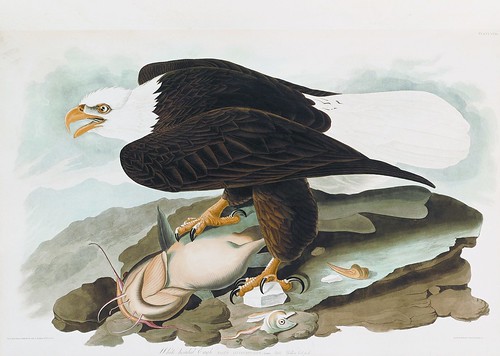
These watercolors are magnificent full-size, aren't they?
That's good to know. I hope I find myself in new York this spring. I'm fortunate to have an original Elephant Folio on exhibit near my home (the page is turned once a month), but I've never seen an original Audubon watercolor--they're so different from the folio plates!
Makes me want to jump on a plane and go to NY to see them! Unfortunately no chance - this year anyway.
Mike
Queensland
Carel; i sure look forward to meeting you when you get to NYC! maybe we can go to the exhibition together? i'd love to hear what you have to say about the paintings.
Mike; this exhibit occurs every spring in NYC, with different watercolors.